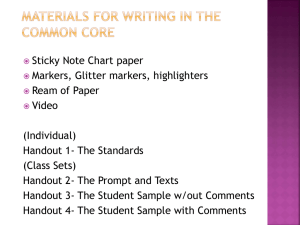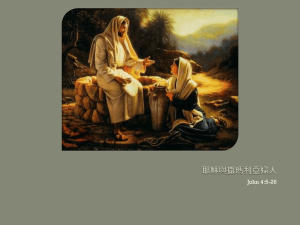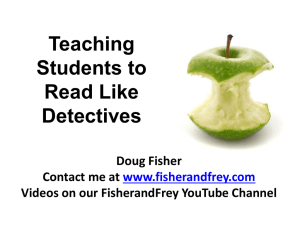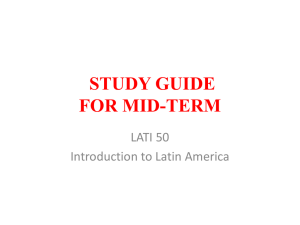I Can Statements, Grades 9-10
advertisement
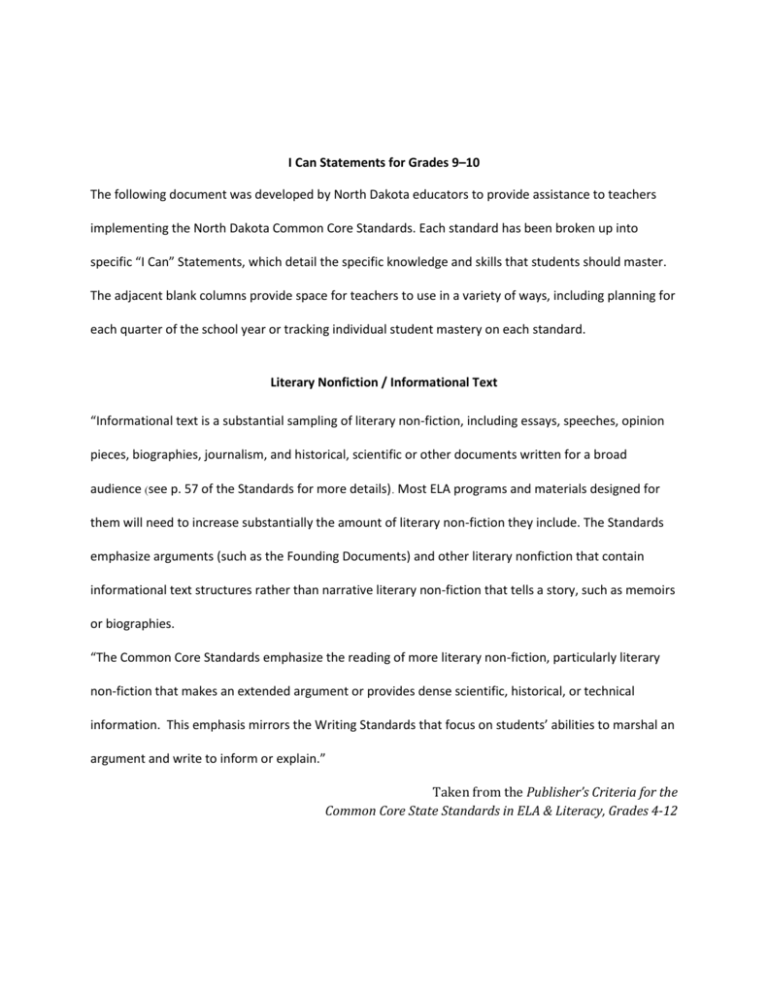
I Can Statements for Grades 9–10 The following document was developed by North Dakota educators to provide assistance to teachers implementing the North Dakota Common Core Standards. Each standard has been broken up into specific “I Can” Statements, which detail the specific knowledge and skills that students should master. The adjacent blank columns provide space for teachers to use in a variety of ways, including planning for each quarter of the school year or tracking individual student mastery on each standard. Literary Nonfiction / Informational Text “Informational text is a substantial sampling of literary non-fiction, including essays, speeches, opinion pieces, biographies, journalism, and historical, scientific or other documents written for a broad audience (see p. 57 of the Standards for more details). Most ELA programs and materials designed for them will need to increase substantially the amount of literary non-fiction they include. The Standards emphasize arguments (such as the Founding Documents) and other literary nonfiction that contain informational text structures rather than narrative literary non-fiction that tells a story, such as memoirs or biographies. “The Common Core Standards emphasize the reading of more literary non-fiction, particularly literary non-fiction that makes an extended argument or provides dense scientific, historical, or technical information. This emphasis mirrors the Writing Standards that focus on students’ abilities to marshal an argument and write to inform or explain.” Taken from the Publisher’s Criteria for the Common Core State Standards in ELA & Literacy, Grades 4-12 ELA 9 – 10 Grade Common Core “I Can” Statements Reading Literature Key Ideas and Details RL.9-10.1. Cite strong and thorough textual evidence to support analysis of what the text says explicitly as well as inferences drawn from the text. RL.9-10.2. Determine a theme or central idea of a text and analyze in detail its development over the course of the text, including how it emerges and is shaped and refined by specific details; provide an objective summary of the text. RL.9-10.3. Analyze how complex characters (e.g., those with multiple or conflicting motivations) develop over the course of a text, interact with other characters, and advance the plot or develop the theme Craft and structure RL.9-10.4. Determine the meaning of words and phrases as they are used in the text, including figurative and connotative meanings; analyze the cumulative impact of specific word choices on meaning and tone (e.g., how the language evokes a sense of time and place; how it sets a formal or informal tone). NDTC April 2012 I Can: Cite strong, thorough, explicit textual evidence Analyze explicit ideas in the text Draw inferences from the text I Can: Determine theme or central idea Analyze how specific details shape the development of the theme Present an objective summary I Can: Analyze complex characters Analyze how characters change and interact throughout the story Analyze the character’s effect on advancement of the plot or development of theme I Can: Determine the meaning of words and phrases as used in the text o Figurative meanings o Connotative meanings Analyze how word choices affect meaning and tone 2 ELA 9 – 10 Grade Common Core “I Can” Statements RL.9-10.5. Analyze how an author’s choices concerning how to structure a text, order events within it (e.g., parallel plots), and manipulate time (e.g., pacing, flashbacks) create such effects as mystery, tension, or surprise. RL.9-10.6. Analyze a particular point of view or cultural experience reflected in a work of literature from outside the United States, drawing on a wide reading of world literature. I Can: Analyze structure of text Analyze order of events Examine author’s manipulation of time and its effect Understand parallel plot Understand flashback I Can: Analyze a point of view taking into account cultural experiences of a character Read a wide range of literature from around the world Integration of Knowledge and Ideas I Can: RL.9-10.7. Analyze the representation Compare and contrast the of a subject or a key scene in two representation of a subject different artistic mediums, including in two different mediums what is emphasized or absent in each treatment (e.g., Auden’s “Musée des Beaux Arts” and Breughel’s Landscape with the Fall of Icarus). RL.8 - (Not applicable to literature) RL.9-10.9. Analyze how an author draws on and transforms source material in a specific work (e.g., how Shakespeare treats a theme or topic from Ovid or the Bible or how a later author draws on a play by Shakespeare). I Can: Define allusion Identify an author’s use of an allusion Analyze how the author transforms the allusion in the studied work Range of Reading and Level of Text Complexity I Can: RL.9-10.10. By the end of grade 9, read and comprehend literature, Comprehend many genres including stories, dramas, and poems, of literature at my grade in the grades 9–10 text complexity level band proficiently, with scaffolding as needed at the high end of the range. By the end of grade 10, read and comprehend literature, including stories, dramas, and poems, at the high end of the grades 9–10 text complexity band independently and proficiently. NDTC April 2012 3 ELA 9 – 10 Grade Common Core “I Can” Statements Reading Informational Text Key Ideas and Details RI.9-10.1. Cite strong and thorough textual evidence to support analysis of what the text says explicitly as well as inferences drawn from the text. RI.9-10.2. Determine a central idea of a text and analyze its development over the course of the text, including how it emerges and is shaped and refined by specific details; provide an objective summary of the text. RI.9-10.3. Analyze how the author unfolds an analysis or series of ideas or events, including the order in which the points are made, how they are introduced and developed, and the connections that are drawn between them. Craft and structure RI.9-10.4. Determine the meaning of words and phrases as they are used in a text, including figurative, connotative, and technical meanings; analyze the cumulative impact of specific word choices on meaning and tone (e.g., how the language of a court opinion differs from that of a newspaper). RI.9-10.5. Analyze in detail how an author’s ideas or claims are developed and refined by particular sentences, paragraphs, or larger portions of a text (e.g., a section or chapter). RI.9-10.6. Determine an author’s point of view or purpose in a text and analyze how an author uses rhetoric to NDTC April 2012 I Can: Cite strong, thorough, explicit textual evidence Analyze explicit ideas in the text Draw inferences from the text I Can: Determine central idea Cite supporting details and analyze how the central idea emerges and is shaped by those details Present an objective summary I Can: Analyze structure of text Analyze order of events or series of ideas Analyze main points and the connections drawn from them I Can: Determine the meaning of words and phrases as used in the text o Figurative meanings o Connotative meanings o Technical meanings Analyze how word choices affect the overall meaning and tone I Can: Examine an author’s development of claims or ideas Determine how ideas or claims are refined by particular parts of the text I Can: Determine point of view Determine purpose 4 ELA 9 – 10 Grade Common Core “I Can” Statements advance that point of view or purpose. Integration of Knowledge and Ideas RI.9-10.7. Analyze various accounts of I Can: a subject told in different mediums (e.g., a person’s life story in both print and multimedia), determining which details are emphasized in each account. RI.9-10.8. Delineate and evaluate the argument and specific claims in a text, assessing whether the reasoning is valid and the evidence is relevant and sufficient; identify false statements and fallacious reasoning. RI.9-10.9. Analyze seminal U.S. documents of historical and literary significance (e.g., Washington’s Farewell Address, the Gettysburg Address, Roosevelt’s Four Freedoms speech, King’s “Letter from Birmingham Jail”), including how they address related themes and concepts. Define rhetoric Analyze how the author uses rhetoric to advance point of view or purpose Compare and contrast the representation of a subject from two different mediums Analyze various accounts to determine which details are emphasized I Can: Define fallacious reasoning Delineate the specific claims Assess valid reasoning Identify false statements Identify fallacious reasoning I Can: Define seminal Analyze significant historical and literary documents Analyze how the documents address related themes and concepts Range of Reading and Level of Text Complexity RI.9-10.10. By the end of grade 9, read I Can: Comprehend nonfiction and comprehend literary nonfiction in writing at my grade level the grades 9–10 text complexity band proficiently, with scaffolding as needed at the high end of the range. By the end of grade 10, read and comprehend literary nonfiction at the high end of the grades 9–10 text complexity band independently and proficiently. NDTC April 2012 5 ELA 9 – 10 Grade Common Core “I Can” Statements Writing Text Types and Purposes W.9-10.1 Write arguments to support claims in an analysis of substantive topics or texts, using valid reasoning and relevant and sufficient evidence. Introduce precise claim(s), distinguish the claim(s) from alternate or opposing claims, and create an organization that establishes clear relationships among claim(s), counterclaims, reasons, and evidence. Develop claim(s) and counterclaims fairly, supplying evidence for each while pointing out the strengths and limitations of both in a manner that anticipates the audience’s knowledge level and concerns. Use words, phrases, and clauses to link the major sections of the text, create cohesion, and clarify the relationships between claim(s) and reasons, between reasons and evidence, and between claim(s) and counterclaims. Establish and maintain a formal style and objective tone while attending to the norms and conventions of the discipline in which they are writing. Provide a concluding statement or section that follows from and supports the argument presented. W.9-10.2. Write informative/explanatory texts to examine and convey complex ideas, concepts, and information clearly and accurately through the effective NDTC April 2012 I Can: Write an argument to support a claim (thesis) Introduce a precise claim Distinguish claim from alternate or opposing claims Clearly organize relationships among claim(s), counterclaims, reasons and evidence Use evidence to support claim(s) and counterclaims fairly Adapt claim(s) and counterclaims to audience’s knowledge level and concerns Use transitions to create cohesion between claim(s) and reasons, reasons and evidence, and claim(s) and counterclaims. Use objective tone Attend to norms and conventions of the subject area in which they are writing Provide a concluding section Write an informative/ explanatory text Organize complex ideas Make important connections 6 ELA 9 – 10 Grade Common Core “I Can” Statements selection, organization, and analysis of content. Introduce a topic; organize complex ideas, concepts, and information to make important connections and distinctions; include formatting (e.g., headings), graphics (e.g., figures, tables), and multimedia when useful to aiding comprehension. Develop the topic with wellchosen, relevant, and sufficient facts, extended definitions, concrete details, quotations, or other information and examples appropriate to the audience’s knowledge of the topic. Use appropriate and varied transitions to link the major sections of the text, create cohesion, and clarify the relationships among complex ideas and concepts. Use precise language and domain-specific vocabulary to manage the complexity of the topic. Establish and maintain a formal style and objective tone while attending to the norms and conventions of the discipline in which they are writing. Provide a concluding statement or section that follows from and supports the information or explanation presented (e.g., articulating implications or the significance of the topic). W.9-10.3. Write narratives to develop real or imagined experiences or events using effective technique, well-chosen NDTC April 2012 Format graphics to enhance writing Choose sufficient facts, extended definitions, etc. appropriate to audience’s knowledge of topic Use varied transitions to link major sections of the text Manage the complexity of the topic using precise language Use an objective tone while maintaining a formal style true to the mode of writing Write a conclusion which articulates the topic’s significance I Can: Write a narrative Create conflict 7 ELA 9 – 10 Grade Common Core “I Can” Statements details, and well-structured event sequences. Engage and orient the reader by setting out a problem, situation, or observation, establishing one or multiple point(s) of view, and introducing a narrator and/or characters; create a smooth progression of experiences or events. Use narrative techniques, such as dialogue, pacing, description, reflection, and multiple plot lines, to develop experiences, events, and/or characters. Use a variety of techniques to sequence events so that they build on one another to create a coherent whole. Use precise words and phrases, telling details, and sensory language to convey a vivid picture of the experiences, events, setting, and/or characters. Provide a conclusion that follows from and reflects on what is experienced, observed, or resolved over the course of the narrative. Production and Distribution W.9-10.4. Produce clear and coherent writing in which the development, organization, and style are appropriate to task, purpose, and audience. (Grade-specific expectations for writing types are defined in standards 1–3 above.) W.9-10.5. Develop and strengthen writing as needed by planning, revising, editing, rewriting, or trying a NDTC April 2012 Use multiple strategies to organize information Establish points of view Introduce narrator and/or in characters in exposition Create a smooth progression of experiences and events Sequence events building on a variety of techniques to create a coherent whole Use vivid details to create a clear picture, setting, and characters Provide a conclusion that resolves and reflects the experience I Can: Develop grade-level appropriate writing I Can: Use revision strategies Use editing strategies 8 ELA 9 – 10 Grade Common Core “I Can” Statements new approach, focusing on addressing what is most significant for a specific purpose and audience. W.9-10.6. Use technology, including the Internet, to produce, publish, and update individual or shared writing products, taking advantage of technology’s capacity to link to other information and to display information flexibly and dynamically. Focus on what is most significant for purpose and audience I Can: Use technology to publish writing Update individual or shared writing products Link to other information in document Display information flexibly and dynamically Research to Build and Present Knowledge I Can: W.9-10.7. Conduct short as well as Conduct a sustained more sustained research projects to research project answer a question (including a self Focus an inquiry on a generated question) or solve a problem or question problem; narrow or broaden the inquiry Solve a problem when appropriate; synthesize multiple sources on the subject, demonstrating Synthesize multiple sources understanding of the subject under Demonstrate understanding investigation. of subject by solving a problem or answering a question I Can: W.9-10.8. Gather relevant information Find authoritative from multiple authoritative print and information from print digital sources, using advanced sources searches effectively; assess the Find information from usefulness of each source in advanced databases and/or answering the research question; other digital sources integrate information into the text Avoid plagiarism by using selectively to maintain the flow of correct citations and ideas, avoiding plagiarism and following a standard format following a standard format for citation. Decide if a source is valid Integrate information into the text to maintain a flow of ideas Produce a bibliography NDTC April 2012 9 ELA 9 – 10 Grade Common Core “I Can” Statements W.9-10.9. Draw evidence from literary or informational texts to support analysis, reflection, and research. Apply grades 9–10 Reading standards to literature (e.g., “Analyze how an author draws on and transforms source material in a specific work [e.g., how Shakespeare treats a theme or topic from Ovid or the Bible or how a later author draws on a play by Shakespeare]”). I Can: Support an analysis, reflection, and research with evidence from literary or informational texts. Apply grades 9–10 Reading standards to literary nonfiction (e.g., “Delineate and evaluate the argument and specific claims in a text, assessing whether the reasoning is valid and the evidence is relevant and sufficient; identify false statements and fallacious reasoning”). Range of Writing W.9-10.10. Write routinely over extended time frames (time for research, reflection, and revision) and shorter time frames (a single sitting or a day or two) for a range of tasks, purposes, and audiences. NDTC April 2012 I Can: Write for many reasons for a variety of audiences. 10 ELA 9 – 10 Grade Common Core “I Can” Statements Speaking and Listening Comprehension and Collaboration I Can: SL.9-10.1. - Engage effectively in a range of collaborative discussions (one-on-one, in groups, and teacherled) with diverse partners on grade 6 topics, texts, and issues, building on others’ ideas and expressing their own clearly. a. Come to discussions prepared, having read or studied required material; explicitly draw on that preparation by referring to evidence on the topic, text, or issue to probe and reflect on ideas under discussion. b. Follow rules for collegial discussions, set specific goals and deadlines, and define individual roles as needed. c. Pose and respond to specific questions with elaboration and detail by making comments that contribute to the topic, text, or issue under discussion. d. Review the key ideas expressed and demonstrate understanding of multiple perspectives through reflection and paraphrasing. I Can: SL.9-10.2. - Interpret information presented in diverse media and formats (e.g., visually, quantitatively, orally) and explain how it contributes to a topic, text, or issue under study. I Can: SL.9-10.3. - Delineate a speaker’s argument and specific claims, distinguishing claims that are supported by reasons and evidence from claims that are not. NDTC April 2012 Participate in one-on-one discussions Participate in group discussions Participate in teacher-led discussions Prepare for a discussion Follow rules for discussions Ask questions of my group members Respond to questions posed by my group members Summarize the group’s discussion Understand others’ perspectives Understand information presented in various formats Explain its value or purpose Define delineate Tell the difference between supported and unsupported claims 11 ELA 9 – 10 Grade Common Core “I Can” Statements Presentation of Knowledge and Ideas I Can: SL.9-10.4. - Present claims and findings, sequencing ideas logically and using pertinent descriptions, facts, and details to accentuate main ideas or themes; use appropriate eye contact, adequate volume, and clear pronunciation. SL.9-10.5. - Include multimedia components (e.g., graphics, images, music, sound) and visual displays in presentations to clarify information. SL.9-10.6. - Adapt speech to a variety of contexts and tasks, demonstrating command of formal English when indicated or appropriate. (See grade 6 Language standards 1 and 3 for specific expectations.) NDTC April 2012 Present claims logically Use descriptions, facts, and details Use appropriate eye contact, volume and pronunciation I Can: Use multimedia components in a presentation I Can: Use formal language in a classroom setting 12 ELA 9 – 10 Grade Common Core “I Can” Statements Language Conventions of Standard English L.9-10.1.- Demonstrate command of the conventions of standard English grammar and usage when writing or speaking.* a. Ensure that pronouns are in the proper case (subjective, objective, possessive). b. Use intensive pronouns (e.g., myself, ourselves).* c. Recognize and correct inappropriate shifts in pronoun number and person. d. Recognize and correct vague pronouns (i.e., ones with unclear or ambiguous antecedents). e. Recognize variations from standard English in their own and others' writing and speaking, and identify and use strategies to improve expression in conventional language. L.9-10.2. - Demonstrate command of the conventions of standard English capitalization, punctuation, and spelling when writing. a. Use punctuation (commas, parentheses, dashes) to set off nonrestrictive/parenthetical elements. b. Spell correctly. I Can: Demonstrate proper usage of the eight parts of speech in writing and speaking Use pronouns in the proper case Use intensive pronouns Correct inappropriate use of pronouns Correct unclear pronouns Find and correct mistakes in own and others’ writing and speaking I Can: Use capitalization and punctuation correctly. Define nonrestrictive elements Define parenthetical elements Use punctuation with nonrestrictive and parenthetical elements Spell correctly Knowledge of Language L.9-10.3.- Use knowledge of language and its conventions when writing, speaking, reading, or listening. a. Vary sentence patterns for meaning, reader/listener interest, and style. b. Maintain consistency in style and tone. NDTC April 2012 I Can: Use proper conventions Use varying sentence patterns Remain consistent in style and tone 13 ELA 9 – 10 Grade Common Core “I Can” Statements Vocabulary Acquisition and Use L.9-10.1.- Determine or clarify the meaning of unknown and multiplemeaning words and phrases based on grade 6 reading and content, choosing flexibly from a range of strategies. a. Use context (e.g., the overall meaning of a sentence or paragraph; a word’s position or function in a sentence) as a clue to the meaning of a word or phrase. b. Use common, grade-appropriate Greek or Latin affixes and roots as clues to the meaning of a word (e.g., audience, auditory, audible). c. Consult reference materials (e.g., dictionaries, glossaries, thesauruses), both print and digital, to find the pronunciation of a word or determine or clarify its precise meaning or its part of speech. d. Verify the preliminary determination of the meaning of a word or phrase (e.g., by checking the inferred meaning in context or in a dictionary). I Can: Use context clues to determine the meaning of a word Use Greek or Latin roots to determine the meaning of a word Use print reference materials Use electronic reference materials L.9-10.5.- Demonstrate understanding of figurative language, word relationships, and nuances in word meanings. a. Interpret figures of speech (e.g., personification) in context.* b. Use the relationship between particular words (e.g., cause/effect, part/whole, item/category) to better understand each of the words. I Can: Use figurative language o Similes o Metaphors o Personification o Idioms o Alliteration o Onomatopoeia o Others: Find relationships between words to better understand them I Can: Use grade-appropriate vocabulary L.9-10.6.- Acquire and use accurately grade-appropriate general academic and domain-specific words and phrases; gather vocabulary knowledge when considering a word or phrase important to comprehension or expression. NDTC April 2012 14

